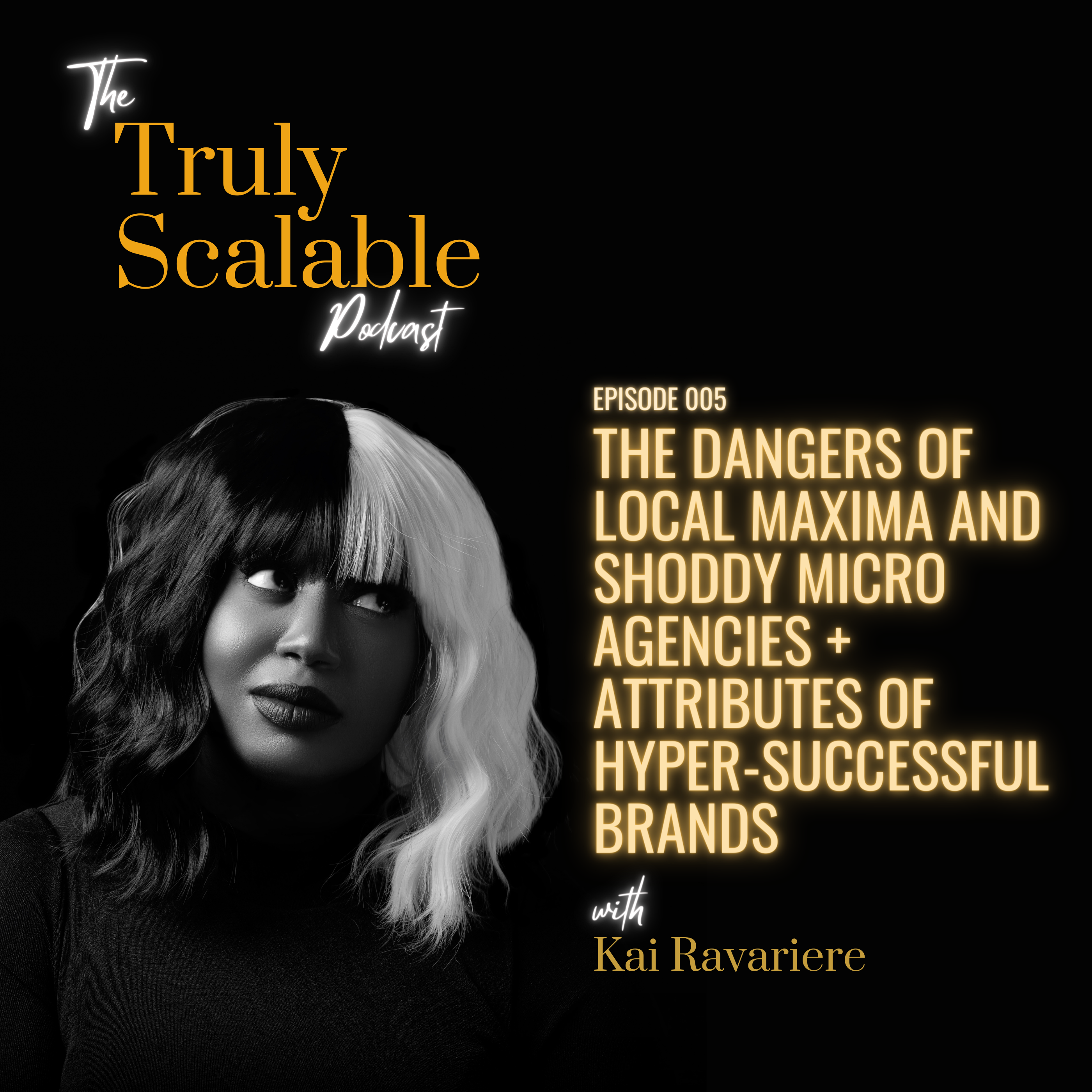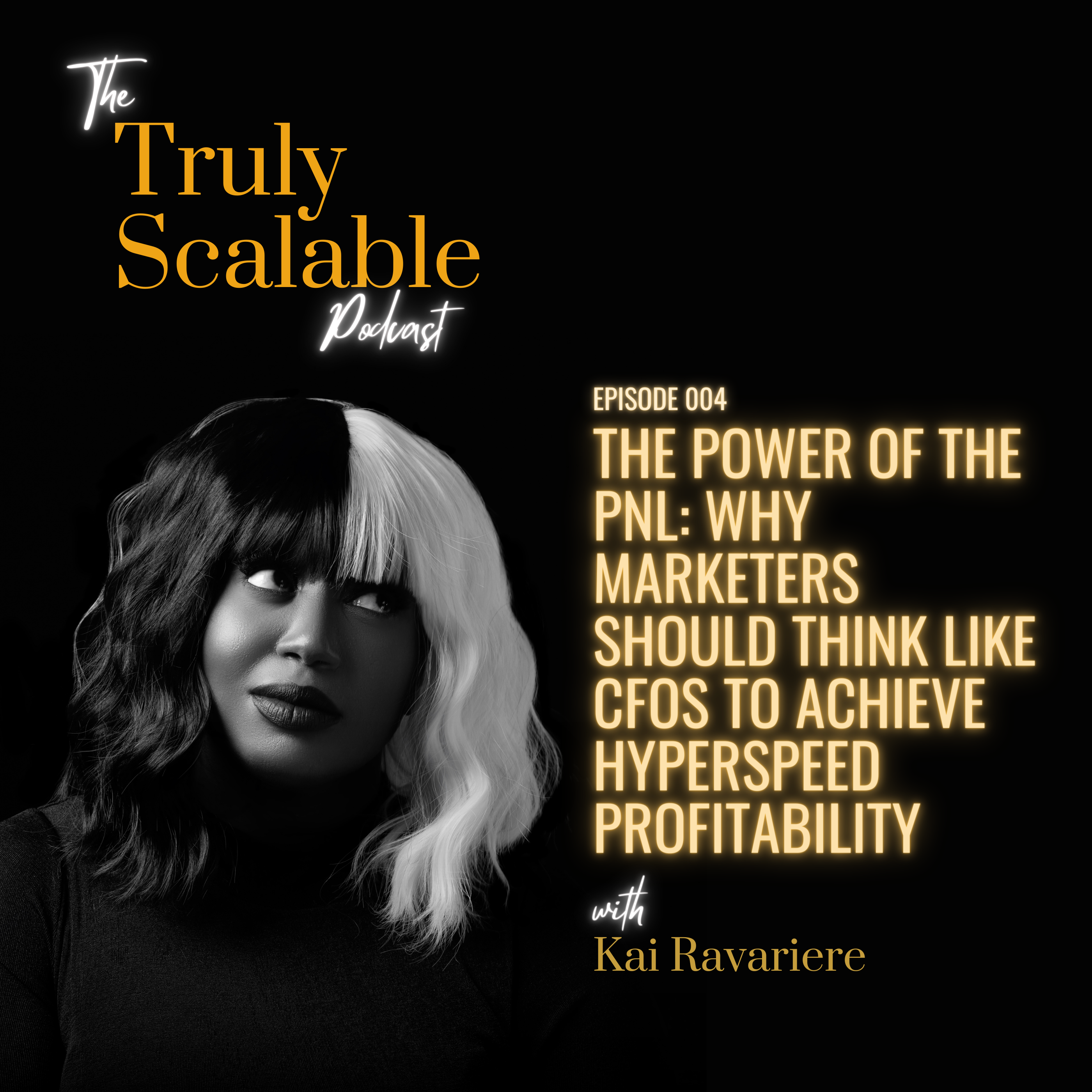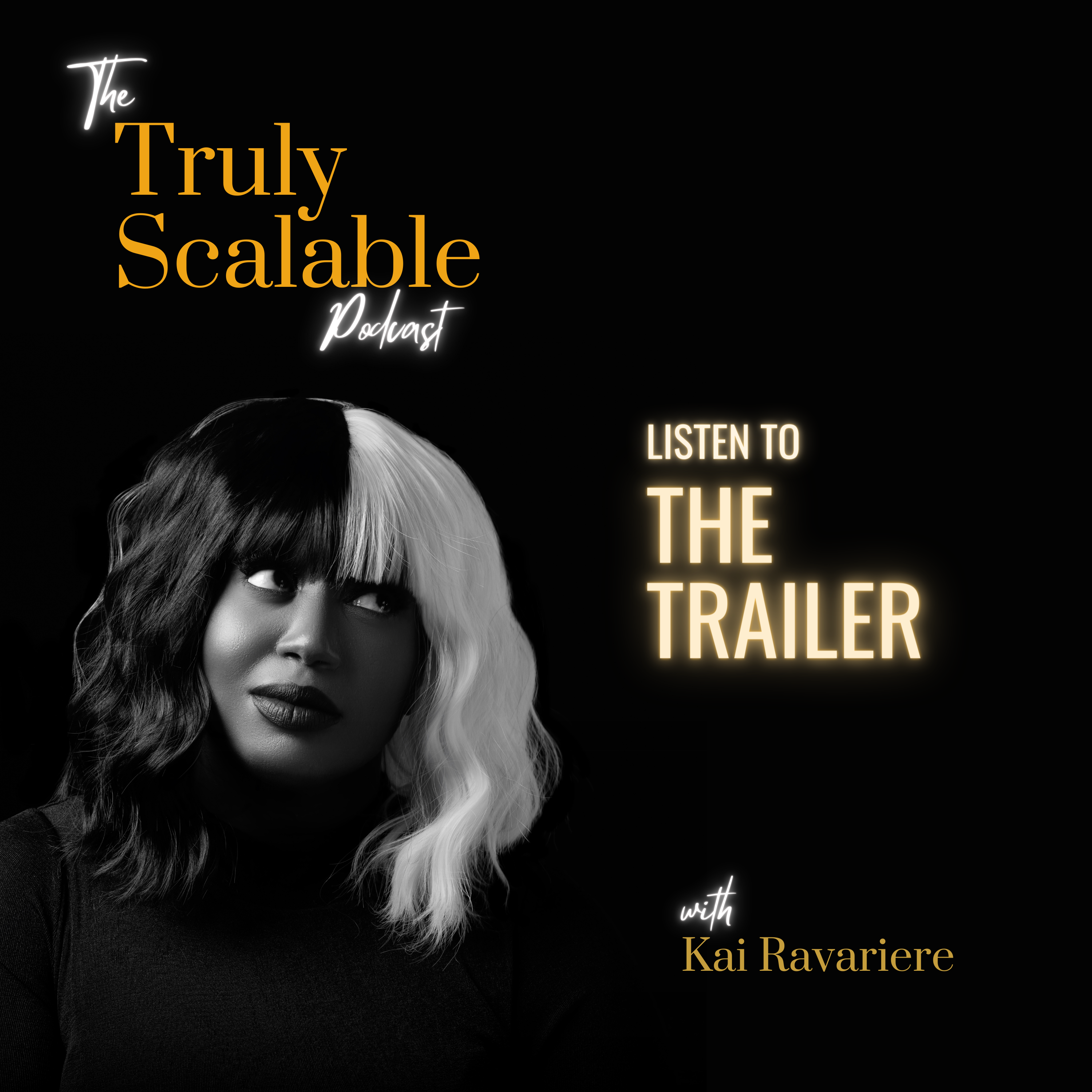[00:00:01] Speaker A: This is the truly scalable podcast, the inner mind of a paid media executive empowering ecommerce brands to optimize and strengthen the backbones of their brands, companies, teams and themselves to ensure a fast, highly profitable scaling, growth and success. However you define it, victories, failures, scandals, cautionary tales lessons on growth scaling frameworks revelations in marketing and advertising join me as I break down frameworks, dispel myths and shift paradigms for e commerce, brand founders and cmos to strengthen the makeup of their businesses and layer smart strategies for maximum profitability at scale. I'm Kaira Varier and I'm here to help you become truly scalable.
[00:00:50] Speaker B: Hey founders, let's dive right in with what went right this week.
Okay, so we held a virtual workshop for our newest clients this week, which is always an exciting affair and really helps them get acclimated to a unique and novel way of thinking about approaching, scaling and growth. Right? Especially for emerging brands in the ecommerce space. Now, this is generally the time where we dispel a lot of myths, we clear up a lot of misconceptions, and we really clear the fog for a lot of founders and operators that have been inundated with a lot of inaccurate benchmarks, low quality approaches and just super short sighted advice spanning years, oftentimes that they now have to unlearn, it's par for the course. We encounter this a lot with new clients and mentees who haven't yet uncovered the boundlessness of their potential as a company where because a brand has never achieved a certain conversion rate before, or because their business besties in the mastermind they are in are leveling out at around the same performance. They make assumptions about what is considered average for their niche and use those assumptions to then limit their expectations in kind. This also limits their own potential when it comes to marketing and sales performance, which usually results in underperforming companies that are rarely truly scalable. When the only data you have access to is your own and maybe a handful of others, you start to believe that the boundaries of possibility are limited to that range of data.
This is the inherent problem with small sample sizes and statistics, too. Small sample sizes rarely paint an accurate picture of the real story of what's really going on.
This is how people draw ludicrous conclusions, like Facebook ads don't work, or like a 2% conversion rate on a $10 product is average. Come on, bro. They look around them in their own tiny bubble and make assumptions about what's really going on outside of it, extrapolating and drawing conclusions that often aren't even accurate. The reality is there are plenty of ecom companies absolutely crushing it right now. There are tons of brands who are seeing incredible success using paid social and plenty of companies enjoying real bottom line profitability even in today's climate. It's akin to baby elephant syndrome. If you haven't heard of this, it's a paradigm of mental conditioning that takes place with elephants when they're very, very young. Essentially, a baby elephant's tied to a strong rope or a chain connected to a pole or a tree, and tries for a time to break free of the rope. As the elephant matures, however, it still believes that it's constrained to that tree or pole. Even though it's gigantic at that point and obviously strong enough to pull free and uproot the whole nine. The elephant still doesn't attempt to break free, even if that chain is replaced by a flimsy rope. The constraint at this point is entirely a mental one. The truth of the matter is this in order to break free of your mental constraints in terms of what's possible, you really need to challenge your perceptions and assumptions of how your ecommerce business should operate. Much of the time, founders are limited to their own experiences, and maybe those of a handful around them, which are often trial by error or fly by night, and rarely reflect the realities of a larger pool, let alone the realities of a larger pool of brands that are doing things differently than many others. Believe it or not, getting founders past the mental constraints they'd bound themselves with is probably the biggest lift of my job. It's not officially in the job description, of course, but because we understand how critical it is to forward momentum and transformational performance, it does become the natural first step. There are a plethora of mental hurdles founders seem to struggle with overcoming in terms of breaking down the assumptions they have about what must be true when it comes to scaling growth, and especially profitability in ecom. For one, that it's not possible to achieve more than 35% profit in a DTC business. There are tons of seven and eight figure companies across landscape who are doing 38, 40, even 45% in profit net of expenses, and are raking in cash to their bank accounts hand over fist, even when their COD or cost of delivery exceeds the optimal 25% to 30% of revenue threshold. Two, that acquiring customers is in its nature expensive and will eat up a lion's share of a company's revenue. While that is true for plenty, it does not have to be true. We've seen CAC at five to 15% of revenue for many, many companies.
Building a percentage tracking into your reporting and PNL can help you overcome the hurdle of analysis fatigue. A lot of your data is best evaluated by looking at it as a percentage of revenue, especially if you want to be able to quickly and accurately benchmark off of large data sets like the ones at reputable agencies. So what factors play into such high performance? Very low return volumes? For one, we're talking sub 1%. This is a known commonality amongst many of the companies enjoying much higher than average profitability. These are generally more common among brands with logical no refund policies, which not all brands can get away with. A good many of these brands also don't do a ton of discounting. Nearly all of them sell products that aren't heavy and therefore don't necessitate high important shipping fees, supplement brands, skincare brands, cosmetic brands, jewelry brands, eyewear, et cetera. In fact, as mentioned in our last episode, shipping costs around 10% of revenue, are generally close to their sweet spot. Pair these elements with a 2.23% average on payment processor freeze and an 18% average on product costs, and you've got the makings to produce outstanding margin. The wildly profitable companies I'm referring to also still value their employees. It's not like they're engaged in some kind of weird exploitation in order to keep costs down, right? They've intentionally built strong company culture into their business ethos. They still have offices, they still have resources and benefits for their employees to make it a good place to work. They're not cutting corners there, but they're not ballooning their opex on lifestyle stuff either. There's no jet sitting on the PNL or anything. They're fully dedicated to being fiscally responsible, and you can see it in their Opex, which sits around 20% on average, about five points lower than our optimal benchmark. Even their payroll, when it comes to full time hires is low, where revenue per employee sits at around 962,000 per FTE on average for highly profitable eight figure brands and about 489,000 per FTE for highly profitable seven figure brands. Which leads me to my next commonality. Almost all of these brands actually have their staff singularly focused, which is why their payroll tends to sit so low at sub 9% of revenue. These brands enjoy very high profitability because they don't have their teams spread thinly across a bunch of different channels like retail, wholesaling, government contracting, et cetera. That requires more staff, more teams, more departments, more concerted distribution efforts that can balloon payroll pretty quickly in order to ensure that each function has the support it needs to excel. Their employees aren't much more talented than that of other brands, they simply have been granted more allowance to focus on being really good at one thing. Now I say this with a caveat. This is not to say that I do not recommend omnichannel approaches or channel diversification that could not be further from the truth. For many challenger brands, a well strategized omnichannel approach can be a lifesaver. I'm just giving you some of the attributes and commonalities that highly profitable brands seem to share based on data. They simply operate with leaner teams and you can still do that and go omnichannel if your organization already has potential for that to be a core competency, like if a founder was an expert in leading sales teams for retail partnerships, for example, but moving on when it comes to who they're hiring their investments in, teams that inherently contribute to retention in a real way are very strong as well. That means customer service relationship management and vip program management are well staffed, intended to they take keen attention to their software and vendor costs, two line items that can easily balloon out of control if left unmonitored or unreferenced when making purchase decisions. And all of this contributes to lower than average Opex as a percentage of revenue. The lower your Opex constraint can be placed, the more innovation, resourcefulness and problem solving that will be required of you and the more you'll require that of your teams. So when done properly, this can drive real rockstar performance as a company that becomes fused into the culture as a company and brand grows.
When it comes to marketing and advertising, their cost to acquire a customer is actually pretty low as a percentage of revenue. They don't balloon ad spend per se. Yes, it is efficiently run to get the very most out of every last dollar. But most importantly, they understand the role that paid social actually plays as the cherry on top of the Sunday. Not the Sunday spoon bowl or the table the Sunday sits on. That means that the lion's share of this efficiency actually comes from the work they do in partnership with consultants like me, agencies like ours, and creative agencies to leverage organic demand. That comes from being very keen with listening to their customers prospects and the overall market to ride the wave of trends rather than spend time manufacturing demand on their own. Think about it this way, if you have to paddle your surfboard against the direction of the wave, you're going to spend a lot more time and energy to move than if you went in the direction of the waves. Yeah, it's a hell of a lot more fun that way, too. Manufacturing demand for your product is the most expensive advertising there is, yet so much of paid social advertising for ecommerce brands seem predisposed to doing just that. Riding a demand wave that's swelling in the market over a trend piece of current news, pop culture gem, or some other mechanism to virality leads to higher efficiency that allows for extremely profitable marketing and advertising. This is what we talk about when we talk about true scalability. We have to have conversations around the levels of organic traffic and the channels outside of the sphere of paid advertising. Many of these brands are seeing figures well beyond our optimal benchmark of 50% organic. Not only that, but nearly all of these brands have recurring revenue that compounds as time goes on, either in the form of a subscription or membership club program. Everything I've mentioned today are things that hyperprofitable brands are obsessively measuring and optimizing against. And the beauty of it all is that still not one of these companies PNL profiles looks the same. You can have CAC at 40% of revenue, but super lean on staffing teams and Opex as a whole and producing incredible product at a very lean product cost. You can have scary low margin like sub 20% and still come out smelling like daisies overall because of the way the rest of your PNL profile is set up to withstand high product costs. The point is to figure out where in your business you have room for leverage to contribute to profitability and what levers you need to be pulling in order to create more leverage and breathing room. This is how you get these bounds and leaps closer to achieving true scalability and realizing your profitability, scaling and growth goals. Naturally, you've got to have a solid command of these numbers and figures first, and that means first having a properly organized chart of accounts that you can quickly look to for guidance. For more on what this looks like, subscribe to the Growth Geek, our weekly newsletter. Later this month, I'll put together a video or a blog post really breaking this down. There will be visuals, promise. Head to www.trulyscalable.com slash subscribe so that you don't miss it.
Next up, I want to get into something that keeps coming up over the years in one way or the other. Now, I've heard stories of unscrupulous agencies doing weird and horrible things to departing or departed clients, but honestly guys, this one takes the cake. Founders I've never heard of anything like this before, so listen to this. I get a text message last week from a respected thought leader in this space who received a frantic sos from another agency. They just onboarded a new client who was switching agencies due to underperformance. They had crossed all their t's, dotted their I's, received access to all the requisite platforms, and were ready to dive in and just get started. Right when one day, one of the media buyers realizes he no longer has access to the ad accounts, nor the company pages. Not on meta, not on Instagram. He taps the account lead who rings up the client to get a sense of what might be going on. The client has no idea what they're talking about and goes in to check the ad account while still on the line with his agency account manager, mind you. But then the client soon realizes they don't have access to the ad account either. In fact, they don't have access to the business manager. Frantic, they begin checking pages. Access is gone. They've been shut out entirely. But that's not all. One by one, the client's teams are checking in with the client over their slack channel. And much to everyone's dismay, it turns out that no one has access to anything.
The TikTok page with 1.2 million followers? Gone. The Shopify store gone. The previous agency, who had access to all of their assets, shut the client and their teams out of every single asset they had just removed. Ad been accessed like it was their own business and kept it pushing. The entire business is run online, they are 100% DTC and every public facing asset was ripped out of their hands overnight, y'all. I almost choked on my bubble tea. Like, how does this even happen now? Luckily, I know a guy who can get accounts and access restored for things like this. But you know what? Most people don't have a guy who knows a guy. And the scary part is this can happen to anyone if they're not careful about who they hire, how they grant access, and when they revoke it. I cannot tell you how many times over the years I have been told by a brand, an influencer, or a thought leader in the space that they or someone they know has had all their ads or customer data deleted on purpose by service providers lacking in morals. This is why, as a general rule, I always tell brands who are transitioning to work with KRA and are in the process of firing their soon to be former agencies to revoke access immediately before terminating. Where feasible. Right? In the event that you have to give 30 day notice or something prior to officially terminating just be sure to keep an eye on all assets and terminate all nonessential access as soon as it makes sense to back in my Wall street days, JP Morgan and the other five banks would have your access revoked while you were being called into that office to get fired, and once you were given word, you were politely escorted out the door. Thankfully, I never had to suffer that fate, but I always took that with me throughout my career while I watched other people walk out of the offices, shutting clients out of their home businesses. These are crimes of passion, y'all. These are situations where the person you've communicated the firing to is very likely the same person in the weeds of all your accounts and back end systems. I say this to say you are significantly more likely to have something like this happen to you when you're hiring a freelancer or a microagency. Yeah, the prices might sound good to some, but the performance is often left wanting anyway, and the fallout can be even worse and more expensive than you can ever imagine. If you do hire a freelancer or microagency for work that is mission critical to the day to day of your business, avoid giving admin access to your accounts wherever you can. Sometimes this is unavoidable, but to the extent that you can mitigate this by using the employee or role based access many platforms do offer, you'll at least mitigate any damage should you run into a shady service provider. This should go without saying, but to all my rookie brands with bright eyed, bushy tailed founders just entering the game, never, ever provide your own login credentials to these platforms. Always create a staff account from which you can grant access, especially on Shopify or another e commerce platform that is literally the hub of all your DTC efforts. Protect it. If all else fails, use a password management system like LastPass to grant access to accounts. That way you can grant and pull access as needed without ever having to supply the actual passwords. And if you or someone you ever know gets locked out or banned from your meta, Google, YouTube, TikTok, or Shopify accounts, drop me a line at
[email protected] with get my account back in the subject line. I know somebody reputable and ethical that I can connect you to who can possibly help you out in ways Facebook reps can't.
[00:16:56] Speaker A: This has been the truly scalable podcast, the inner mind of a paid media executive empowering ecommerce brands to optimize and strengthen the backbones of their brands, companies and teams to ensure fast, highly profitable scaling and growth in any climate.
[00:17:10] Speaker B: Thanks for listening today. If this has been insightful, entertaining or interesting, subscribe and leave a review. They really do help drop some insight into topics you'd like to hear me get into too. I read all suggestions and we'll incorporate them into future episodes. Are you yearning to find better, smarter ways to scale and grow? Does the growing competition in this industry and the ever changing facets of digital advertising have you experiencing stagnant growth, declining revenue or lack of profitability? Do you feel like you must be missing key pieces to the puzzle that would help you get to where you.
[00:17:40] Speaker A: Know your brand could and should be?
[00:17:42] Speaker B: Has your growth journey felt stressful, tedious or underwhelming lately? Sounds like you could use a growth geek, our free weekly email newsletter that's packed with lessons, insights, perspectives on entrepreneurship, scaling, leadership in all things marketing and advertising.
[00:17:57] Speaker A: For ecommerce, sign up for free at.
[00:18:00] Speaker B: Ww dot trulyscalable.com subscribe thanks again for.
[00:18:04] Speaker A: Joining me on this episode of Truly Scalable.





